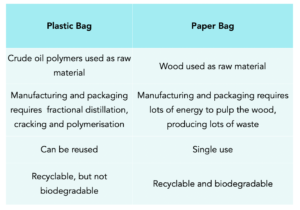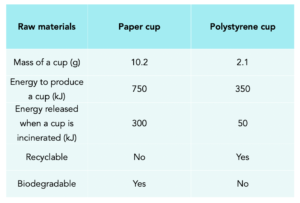Life Cycle Assessment (GCSE Chemistry)
Life Cycle Assessment
Life Cycle Assessment
The Environmental Impacts of Products
- Life cycle assessments assess environmental impact. Life cycle assessments (LCA) can assess the environmental impact of a product’s life cycle. This includes the uses of water, energy sources and production of wastes, as well as the production of pollutants like carbon dioxide which is a greenhouse gas.
- LCAs have 4 main stages to be assessed. The four main stages of LCAs that should be assessed are extracting and processing raw materials; manufacturing and packaging; use and operation during its lifetime; disposal at the end of its useful life. We also have to look at the transport and distribution at each stage.
1. Extracting and processing raw materials. When raw materials are extracted and processed at the beginning of a product life cycle, pollution can occur. This is because extraction and processing of raw materials can use a lot of energy.
Examples of pollution which arise from extracting different raw materials.
- Extracting metals: Metal mining causes acidic solutions which can leach into water bodies and kill organisms. Dust from mines can cause respiratory problems.
- Extracting crude oil to make plastics: Carbon dioxide from burning fossil fuels is a greenhouse gas, causing global climate change. Lots of fuel is burnt to use heavy machinery in mining and drilling.
- Extracting wood to make paper: Deforestation reduces biodiversity
2. Manufacturing and packaging. Both the manufacturing and packaging of a product can use a lot of energy. Similar to the first step, this can also produce a lot of pollution. Disposing of any waste products can also use up a lot of energy.
3. Use and operation during the product lifetime. Use of products can produce pollution, for example, the burning of fuels. The more a product is used, the more pollution it could create.
4. Disposal at the end of its useful life. Once a product has come to the end of its life, it must be disposed of. This can cause pollution in the form of creating landfill sites. Methane gas, a greenhouse gas, is made in landfill sites.
Quantifying the Use of Resources
Allocating Numerical Values
- Resource use can be quantified. We can quantify the use of resources in a life cycle assessment. For example, we could quantify the number of litres of water used to create a product.
- LCA assessment is not purely objective. Despite being able to place a number of resources used in an LCA, this is not an objective process. It is much more difficult to quantify the effects of pollution at each stage.
Misuse of LCAs
- LCA assessment is not objective. As we’ve just seen, it is difficult to quantify exact values in an LCA. This means that they are not objective values – they are subjective.
- LCAs can be misused. Companies can misuse LCAs to portray their products in a positive light. People may be more likely to buy a product if they think it has a minimal environmental impact.
Comparing Simple LCAs
For exams, you need to be able to compare LCAs. We’ll go through an example here, comparing plastic and paper bags.

Worked example: The following table gives information on paper cups and polystyrene cups. Use a life cycle assessment to compare the cups. (6 marks)

Model Answer:
(Extracting raw materials) The paper cup is made from wood; a renewable resource. However, it does use up a large amount of land, which means less is available for agriculture or food. Deforestation reduces biodiversity. The plastic cup is made from crude oil; this is finite.
(Manufacturing) Paper cups need more energy to make (750 kJ), so they will release more carbon dioxide, a greenhouse gas which causes more global warming. More fossil fuels will be used, so using up the finite resource more. Making paper also requires a lot of water, increasing the potential for water pollution.
(Transport) Paper cups are heavier to transport (10.2 g), so more energy for fuels needed. More carbon dioxide is produced, which causes more global warming. Both have the same packaging.
(Usage) Both are single-use so neither has an advantage. No pollution is produced in their use.
(Disposal) Paper can be incinerated, so energy can be used for other purposes. This reduces the need for fossil fuels. Paper does not remain in land fill for a long time as it is biodegradable. Polystyrene can release toxins on incineration, and does not decompose, so will be in landfill for a long time. Polystyrene, however, can be recycled and so conserves finite resources. Fewer cups made from polystyrene will end up in landfill.
(Overall judgement) Overall I think the polystyrene cup is the best. Although it relies on the use of fossil fuels for its raw materials, it uses half the amount of fossil fuels in its manufacture and five times less in its transport, as it is lighter. Also it can be recycled, which means less materials need to be extracted, as it can be made into other objects. It does not need water in its manufacture.
Life Cycle Assessment (LCA) is a method used to evaluate the environmental impact of a product or process over its entire life cycle. This includes every stage of its production, use, and disposal. The goal of LCA is to identify areas where improvements can be made to reduce the environmental impact of a product or process.
LCA is important because it provides a comprehensive understanding of the environmental impact of a product or process. It helps to identify areas where improvements can be made to reduce this impact, and it provides information that can be used to make more sustainable choices.
An LCA study includes an assessment of the environmental impact of a product or process from raw material extraction, through production, use, and disposal. It evaluates the use of energy, water, and other resources, as well as the emissions of greenhouse gases and other pollutants.
LCA is conducted using a step-by-step approach, which includes the following stages:
Defining the scope of the study
Identifying the inputs and outputs of the product or process
Measuring the environmental impact of the inputs and outputs
Analyzing the results and identifying areas for improvement
The benefits of LCA include:
Improved understanding of the environmental impact of a product or process
Identification of areas where improvements can be made to reduce the impact
Improved decision-making for more sustainable products and processes
Better communication of the environmental impact of products and processes to stakeholders
The limitations of LCA include:
The difficulty in accurately measuring the environmental impact of some inputs and outputs
The need for data from various sources, which can be time-consuming and expensive to gather
The complexity of the process, which may require the assistance of experts
LCA can be used in the real world to evaluate the environmental impact of products and processes, and to make more sustainable choices. It is used in industries such as construction, manufacturing, and transportation to assess the environmental impact of products and processes and make improvements where necessary.
LCA plays a crucial role in sustainability by providing a comprehensive understanding of the environmental impact of products and processes. This information can be used to make more sustainable choices, reduce the environmental impact of products and processes, and improve the overall sustainability of the environment.
LCA will continue to be an important tool for evaluating the environmental impact of products and processes in the future. As sustainability becomes increasingly important, LCA will be used more frequently to make informed decisions and drive sustainable change. In addition, advances in technology and data gathering methods may improve the accuracy and efficiency of LCA in the future.





Still got a question? Leave a comment
Leave a comment